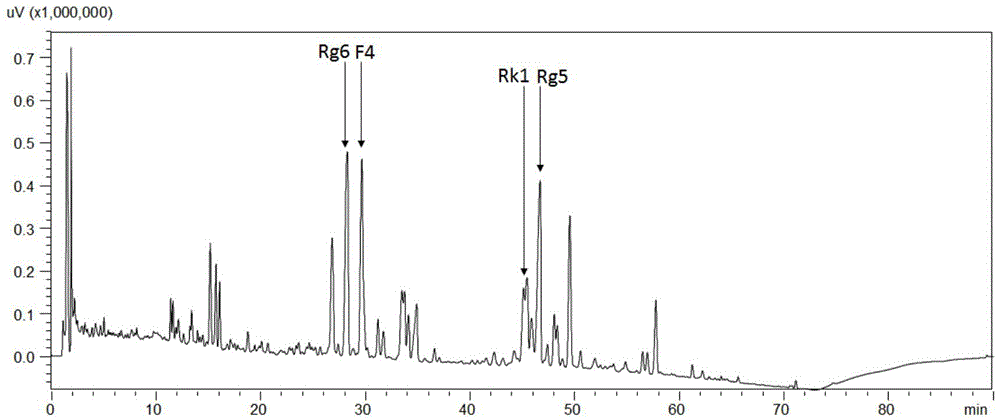Multifunctional handmade soap containing rare ginseng saponins
A technology for rare ginseng saponins and handmade soaps, applied in the directions of alkali soap/ammonium soap compositions, organic compound-containing washing compositions, molded soaps, etc., can solve the problem of no quality control of active substances, organic solvent residues, affecting the shelf life of handmade soaps, etc. question
- Summary
- Abstract
- Description
- Claims
- Application Information
AI Technical Summary
Problems solved by technology
Method used
Image
Examples
Embodiment 1
[0020] Example 1 Preparation and component analysis of ginseng rare saponins
[0021] Ginseng stems and leaves are used as raw materials. Ginseng stems and leaves are extracted by conventional techniques to obtain total saponins from ginseng stems and leaves. The total saponins from ginseng stems and leaves are then subjected to high temperature and high pressure pyrolysis to prepare rare ginseng saponins. The rare ginsenosides produced mainly include ginsenoside Rk1 , Rg5, Rg6 and F4 and other components.
[0022] The specific operation is as follows: 5 kg of ginseng stem and leaf coarse powder, use 10 times the amount of water or dilute alcohol as solvent to carry out reflux extraction for 3 times, each time for 4 hours, combine the extracts, concentrate to extract, disperse with water, pass through D101 macroporous resin, Elute with water and different concentrations of ethanol in sequence, collect the fractions containing ginsenosides, and then concentrate to dryness to ob...
Embodiment 2
[0023] Example 2 Preparation and component analysis of platycodon root extract
[0024] The 2-3 year-old platycodon root is used as a raw material, and the platycodon root extract is obtained through conventional extraction. The specific operation steps are as follows:
[0025] 5 kg of dried platycodon root powder, ultrasonically extracted 3 times with 10 times the amount of water solvent, 1 hour each time, combined extracts, concentrated until no alcohol smell, freeze-dried to obtain about 750 g of platycodon root water extract, after HPLC The detection mainly contains abundant platycodon saponins and tangshenylosides and other components, see attached figure 2 .
Embodiment 3
[0026] The preparation method of embodiment 3 handmade soap is preferred
[0027] Serial number (NO.) Additives Amount added (%) 1 coconut oil 10.0 2 palm oil 25.0 3 olive oil 30.0 4 sodium hydroxide 10.0 5 Rare Ginseng Saponins 1.0 6 Platycodon Root Extract 2.0 7 Deionized water 22.0
[0028] Put the above-mentioned coconut oil, palm oil, and olive oil into the reactor in turn, start the agitator (10rpm) and stir evenly, raise the temperature to 30°C, and keep warm for later use;
[0029] Under rapid stirring (30rpm), dissolve sodium hydroxide in an appropriate amount of water, and cool to 30°C after completely dissolving;
[0030] Slowly add the above sodium hydroxide solution into the reactor and stir rapidly (30rpm) until the soap becomes thicker (viscosity 6000-8000mPa.s);
[0031] After dispersing the rare ginseng saponins and platycodon root extracts with the remaining deionized water, add them in...
PUM
 Login to View More
Login to View More Abstract
Description
Claims
Application Information
 Login to View More
Login to View More - R&D
- Intellectual Property
- Life Sciences
- Materials
- Tech Scout
- Unparalleled Data Quality
- Higher Quality Content
- 60% Fewer Hallucinations
Browse by: Latest US Patents, China's latest patents, Technical Efficacy Thesaurus, Application Domain, Technology Topic, Popular Technical Reports.
© 2025 PatSnap. All rights reserved.Legal|Privacy policy|Modern Slavery Act Transparency Statement|Sitemap|About US| Contact US: help@patsnap.com


